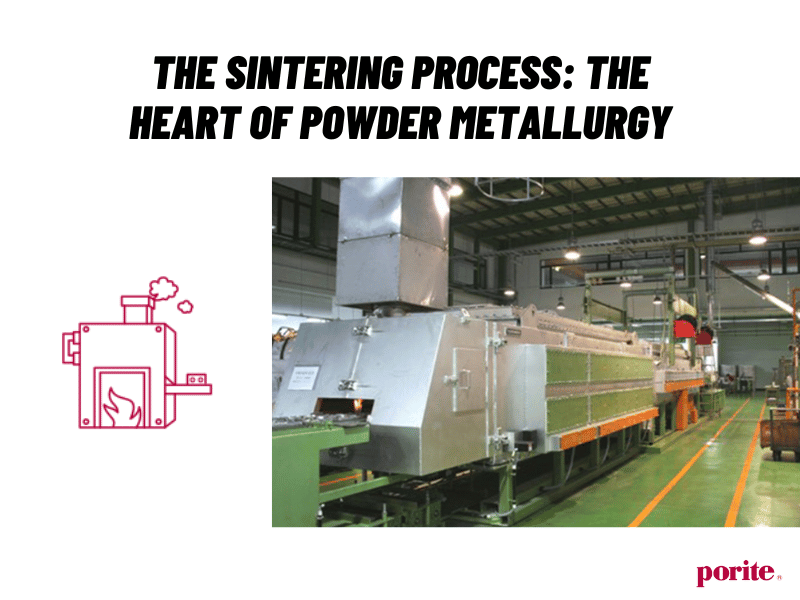News Release
Media
The Sintering Process: The Heart of Powder Metallurgy

Introduction
In the world of powder metallurgy (PM), one process stands at the very core of turning loose metal powders into strong, functional components — sintering. Often described as the "heart" of powder metallurgy, the sintering process transforms pressed metal powder compacts into solid parts with excellent mechanical properties and dimensional precision.
This article explores what sintering is, how it works, why it’s so critical, and how it compares to conventional metalworking techniques.
________________________________________
What is Sintering?
Sintering is a heat treatment process that occurs after metal powder has been compacted into a desired shape (known as a "green part"). During sintering, the part is heated in a controlled atmosphere to a temperature below the metal’s melting point. This causes the metal particles to bond at the atomic level through diffusion, densifying the material and increasing its strength and integrity.
________________________________________
How Sintering Works: Step-by-Step
1. Preheating
The green part is gradually heated to eliminate any moisture or lubricants used during pressing. This helps prepare the material for efficient diffusion.
2. Sintering Stage (High-Temperature Soak)
The part is heated to a high temperature (typically 70–90% of the metal’s melting point), allowing atomic diffusion between powder particles. The structure begins to densify, forming strong metallurgical bonds.
3. Cooling
After sintering, the part is slowly cooled in a controlled environment to prevent thermal shock, distortion, or oxidation. The result is a solid component with improved mechanical properties.
________________________________________
Why Sintering is Critical in Powder Metallurgy
✅ Strength and Durability
Before sintering, the pressed component (green part) is fragile. Sintering gives the part its required structural strength, enabling it to function in real-world applications such as gears, bearings, and structural brackets.
✅ Dimensional Stability
Proper sintering ensures minimal shrinkage and precise dimensions, making it ideal for applications that demand tight tolerances.
✅ Customizable Density
By adjusting sintering conditions and powder composition, manufacturers can produce parts with controlled porosity, which is especially useful for self-lubricating bearings and filtration components.
✅ Enhanced Material Properties
Sintered parts can exhibit:
- Improved hardness
- Increased wear and fatigue resistance
- Tailored thermal and electrical conductivity
________________________________________
Types of Sintering Atmospheres
To prevent oxidation and control chemical reactions during sintering, the process is carried out in specific atmospheres, such as:
- Hydrogen: Clean reducing environment for stainless steels and sensitive metals.
- Nitrogen: Common and cost-effective for iron-based parts.
- Vacuum: Used for reactive or specialty alloys.
- Endothermic Gas (Endogas): A mixture of gases suitable for many standard sintering operations.
________________________________________
Porite's Expertise in Sintering
At Porite, sintering is more than just a production step — it’s a precision-driven process backed by decades of expertise. With 54 continuous sintering furnaces, Porite can handle high-volume production with consistent quality. Our advanced sintering capabilities allow us to:
- Optimize part strength and density
- Maintain tight dimensional tolerances
- Support custom alloy systems and high-performance applications
________________________________________
Sintering vs. Other Metalworking Techniques
| Process | Temperature Range | Material Use Efficiency | Complexity of Shapes | Surface Finish |
|---|---|---|---|---|
| Sintering | Below melting point | High | High (near-net shape) | Good |
| Casting | Above melting point | Medium | High | Varies (often needs machining) |
| Forging | High pressure and heat | Medium | Low–Medium | Good |
| Machining | Room temperature | Low (material waste) | High (post-processing) | Excellent |
________________________________________
Conclusion
The sintering process is truly the foundation of powder metallurgy. By fusing individual metal particles into a unified whole, sintering imparts strength, precision, and functionality to components that are used across a wide range of industries — from automotive and industrial to medical and consumer electronics.
With the right materials, controlled atmosphere, and advanced technology, sintering allows manufacturers to create parts that are both high-performing and cost-effective. At Porite, our investment in sintering technology ensures our customers receive consistent, top-quality parts that meet the demands of modern manufacturing.
Contact Us
Interested in learning how Porite's advanced sintering technology can enhance your products?
Whether you need custom sintered components or expert consultation, we're here to help.
Contact Us Now and let's create high-performance solutions together.
